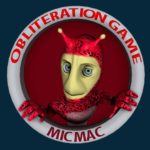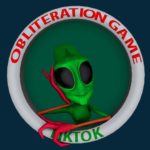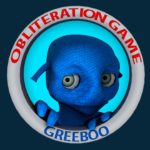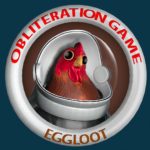Developer: Desert Owl Games | Publisher: ToHeroes Game Studios || Outlook: Not Good
Space Wars: Interstellar Empires ventures into the bold frontier of slow, turn-based MMO. Space Wars: Interstellar Something or Other takes the usual issue you have with this genre, speed of gameplay, and doubles the issue by having two phases per turn. It’s a bit baffling how anyone can have the patience to play when the rule-set is laid out like this, not to mention since this is an MMO where you have to grind to get anywhere. Uhh… No thanks.
For me, it was easy to make the comparison to Star Trek: Online. You have warring factions, you get a ship, then you have space battles. You allocate shields, power, choose which weapons to shoot, yadda yadda. Except where Star Trek: Online is all real-time, you have a slow and plodding turn-based mechanic in Space Wars. Don’t get me wrong, I have no qualms with it being turn-based by design, where it becomes an issue is speed and seemingly needless complexity.
As stated, Space Wars has two phases per turn — an Allocation phase and a Combat phase. Each turn has an Allocation phase where, depending on the stage of the battle, you decide what issues to fix and how to change your combat posture. Your combat posture includes allocating power to different systems such as shields, movement, weapons, etc. You can also repair damage if you’ve got any to repair. This phase lasts until everyone hits “End Turn” but the maximum amount of time is sixty full seconds. Then, you have the Combat phase where everyone gets their own sixty full seconds to make their moves and attack considering the preparations they made in Allocation mode. Depending on how many ships are in battle, your turn may not come for another few minutes, and after you’re done with your turn, it could be another few minutes before the Allocation phase starts all over again. We’re talking about the potential of ten to fifteen minutes per turn at this point, and I already want to open the airlock and get sucked into the emptiness of space. At least I’d die quicker that way, and wouldn’t have to live knowing how much of a disappointment Star Wars: The Last Jedi was.
The interface isn’t bad, but does feel outdated. It isn’t really pleasurable to hit the different buttons and modify shields by clicking just the right pixel or clicking multiple times to modify one piece of your Allocation phase’s bells and whistles. The interface adds to the feeling that there is a layer of needless complexity involved, and many of the numbers/doohickeys don’t feel rewarding considering the gameplay flow. Each weapon you shoot has a targeting arc meaning you have to be pointing the right direction to shoot. You can change the direction your ship is facing to shoot with your other weapons in the same Combat phase, so its like why do I have to go through all of those hoops? Just automate it for me, or simplify it with some other value. I don’t want to control my weapons through three different mechanics, I just want to control them directly.
On a grander scale the game is based on PVP between factions, which two of the four are currently available during this phase of Early Access. The map is persistent as each faction vies for more territory and the only way for a faction to expand is to take over another faction’s slice of the galaxy. Entering on-going fights to help out in this effort is the highlight of this dynamic. However, if you enter a sector already in the midst of battle, you’ll be stuck in a limbo of sorts until the battle has a “Transit” phase, typically after a full turn has been completed. I can appreciate that tactics may all of a sudden change when new players enter the battle as existing battles rage on, but it sucks for the person waiting upwards of what could be five or ten minutes before they get to do anything without forewarning. Also, there is information on what ships are currently fighting, but this can change at any point since players hop in and out all the time. If you go into the sector looking to fight similar ships to you, you may just end up fighting ships that can one-shot you instead. Now that’s what I call fun!
There are some PVE missions to take part in. While the gameplay flow is much less cumbersome, it’s also not as eventful and half of the time you’re searching for the enemy on a large map, hoping you run across them before Alt-F4 becomes a viable plan to defeat them. There is also an XP system and Leadership Points that you can earn to unlock things and progress your Captain/Crew. Of course, as a free to play game, there are currencies you can purchase to improve your game and skip all of the grinding and immediately begin to pound asses without knowing what the hell you’re doing. So there’s, that, too.
Since the game is in Early Access, all of your progress and characters can be reset to scratch at any time, without notice. Cool! Granted the game can change drastically from one patch to the next, it doesn’t exactly inspire me to keep playing something coined as an MMO if progress can be reset on whim. What is the point, especially when it takes a lot of time to get a level or unlock ships? I don’t even get brownie points for the 10 xp I earned before the reset.




















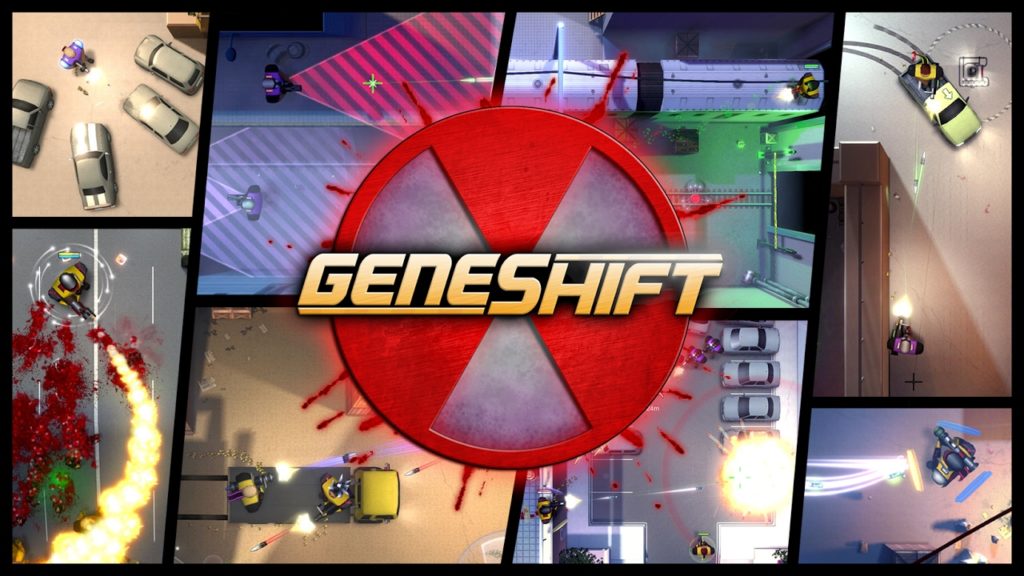
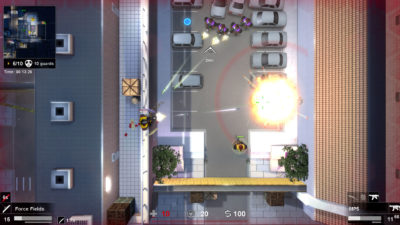 Geneshift is a top-down shooter, much like classic Grand Theft Auto games DMA Designs made before Nintendo got to them (yeah-I said it, bitch) and fucked the company into bankruptcy. You walk, you jump (surprisingly), you shoot. Occasionally you’ll use an ability, or drive a car. On the surface, it’s pretty simple. You’re a mercenary working for some lab, killing rebels or terrorists or something. Nothing particularly amazing, but it gets the job done. I don’t think it’s anything memorable, but it’s not the driving force behind this game.
Geneshift is a top-down shooter, much like classic Grand Theft Auto games DMA Designs made before Nintendo got to them (yeah-I said it, bitch) and fucked the company into bankruptcy. You walk, you jump (surprisingly), you shoot. Occasionally you’ll use an ability, or drive a car. On the surface, it’s pretty simple. You’re a mercenary working for some lab, killing rebels or terrorists or something. Nothing particularly amazing, but it gets the job done. I don’t think it’s anything memorable, but it’s not the driving force behind this game.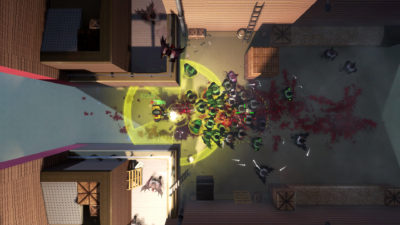 So, the grade versus the lack of description- what’s a game gotta do to get a “meh” around here? While Geneshift isn’t particularly out of this world, or a “must play” sort of game, it’s not really a bad one, or even one that’s just kind of okay. Simple, clean-looking games have their place. Soldat. Agar.io. LYNE. You could put Geneshift in that sort of group: simple games that are for casual consumption. There’s nothing sloppy about the controls or their implementation, and it can be rather fun at times, but it somehow it doesn’t offer enough to me. It’s got deathmatch, it’s got cooperative campaign options, it’s got a lot of the makings of something I would want to play often. For some reason, though, the perspective doesn’t do it for me like I felt it would when I initially started playing. Guns have variable engaging ranges, but they all end up averaging out once you factor in the perspective you play the game at. While it’s not inherently bad because of the perspective, the gameplay becomes somewhat tedious. Shooting enemies from below still takes cover into account, so sometimes you have to click on a very precise location to shoot someone that appears to be peeking by a ledge. Knowing what you can climb isn’t obvious without jumping up and down, which prompts ledges to highlight. Nothing’s particularly broken, but too often is there a moment where I get caught doing a jump and get stuck, or have to battle a level’s design because it requires perfect timing in jumps (no shit, by the way; I beat all of Cuphead on hard, but Geneshift is the only game in recent memory that managed to piss me off with a section of platforming).
So, the grade versus the lack of description- what’s a game gotta do to get a “meh” around here? While Geneshift isn’t particularly out of this world, or a “must play” sort of game, it’s not really a bad one, or even one that’s just kind of okay. Simple, clean-looking games have their place. Soldat. Agar.io. LYNE. You could put Geneshift in that sort of group: simple games that are for casual consumption. There’s nothing sloppy about the controls or their implementation, and it can be rather fun at times, but it somehow it doesn’t offer enough to me. It’s got deathmatch, it’s got cooperative campaign options, it’s got a lot of the makings of something I would want to play often. For some reason, though, the perspective doesn’t do it for me like I felt it would when I initially started playing. Guns have variable engaging ranges, but they all end up averaging out once you factor in the perspective you play the game at. While it’s not inherently bad because of the perspective, the gameplay becomes somewhat tedious. Shooting enemies from below still takes cover into account, so sometimes you have to click on a very precise location to shoot someone that appears to be peeking by a ledge. Knowing what you can climb isn’t obvious without jumping up and down, which prompts ledges to highlight. Nothing’s particularly broken, but too often is there a moment where I get caught doing a jump and get stuck, or have to battle a level’s design because it requires perfect timing in jumps (no shit, by the way; I beat all of Cuphead on hard, but Geneshift is the only game in recent memory that managed to piss me off with a section of platforming).

















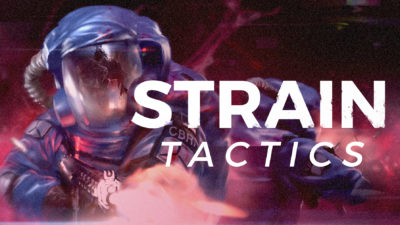
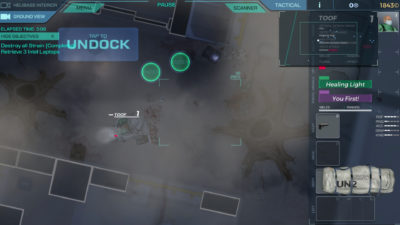 Alright, grab an XCOM. Any one of them will do, we’re just going for basic themes here. Dump that in. Now, scoop up some Alien Swarm (it’s free) and plop that in there, too. Now, and this is important, add a dab of tower defense. Just a bit. Trust me: it’ll make some sense. Hit “blend” and watch those mix up. Take the pitcher of your rather interesting mix of genres and pour that shit into a phone and you’ve got Strain Tactics from Touch Dimensions Interactive.
Alright, grab an XCOM. Any one of them will do, we’re just going for basic themes here. Dump that in. Now, scoop up some Alien Swarm (it’s free) and plop that in there, too. Now, and this is important, add a dab of tower defense. Just a bit. Trust me: it’ll make some sense. Hit “blend” and watch those mix up. Take the pitcher of your rather interesting mix of genres and pour that shit into a phone and you’ve got Strain Tactics from Touch Dimensions Interactive.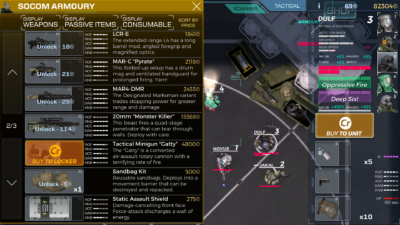 Despite most of the game revolving around directly positioning your squad members and marking targets to shoot (though they engage automatically if enemies are in range), the squad’s helicopter is fully controllable at all points of gameplay. The helicopter acts as a storage locker for gear, a transport for players and NPCs, and fire support against visible targets on the ground, which gives the player immense amounts of control about how they deploy, what their troops are armed with and what their exit point will be. Your team begins each mission aboard the heli, and they don’t disembark until you’ve decided to. It’s a refreshing amount of choice in a genre that routinely grants you limited power despite your role as a “commander” or whatever. When was the last time you had the option of landing your squad near your target in XCOM rather than running a fucking marathon from your drop zone? Oh, never? What about using your dropship to blast the shit out of dangerous enemy units before they become a threat to your squad’s objectives? What?! Never?! What a shame! It’s okay, though: Strain Tactics lets you do that. Using a minigun, a small cannon, or even some big ass firebombs, the helicopter can lay waste to outside targets. While it’s not always a viable option, what with interior locations and the occasional heavy foliage area, it’s a rather interactive way to support your squad in a way that makes a ton of sense. Why this hasn’t been done before in mainstream titles is baffling to me, but Strain Tactics delivers this sort of engaging gameplay dynamic in a tight little package. I’d dare to say that it’s something you could make a franchise off of.
Despite most of the game revolving around directly positioning your squad members and marking targets to shoot (though they engage automatically if enemies are in range), the squad’s helicopter is fully controllable at all points of gameplay. The helicopter acts as a storage locker for gear, a transport for players and NPCs, and fire support against visible targets on the ground, which gives the player immense amounts of control about how they deploy, what their troops are armed with and what their exit point will be. Your team begins each mission aboard the heli, and they don’t disembark until you’ve decided to. It’s a refreshing amount of choice in a genre that routinely grants you limited power despite your role as a “commander” or whatever. When was the last time you had the option of landing your squad near your target in XCOM rather than running a fucking marathon from your drop zone? Oh, never? What about using your dropship to blast the shit out of dangerous enemy units before they become a threat to your squad’s objectives? What?! Never?! What a shame! It’s okay, though: Strain Tactics lets you do that. Using a minigun, a small cannon, or even some big ass firebombs, the helicopter can lay waste to outside targets. While it’s not always a viable option, what with interior locations and the occasional heavy foliage area, it’s a rather interactive way to support your squad in a way that makes a ton of sense. Why this hasn’t been done before in mainstream titles is baffling to me, but Strain Tactics delivers this sort of engaging gameplay dynamic in a tight little package. I’d dare to say that it’s something you could make a franchise off of.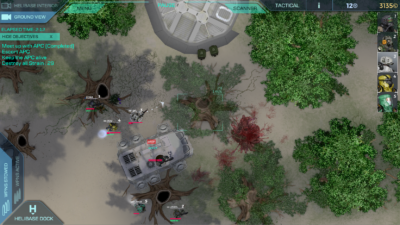 However, the honeymoon isn’t long. The game has problems, one so heinously rooted that I’m not entirely sure it can be easily fixed with patches: it’s a phone game.
However, the honeymoon isn’t long. The game has problems, one so heinously rooted that I’m not entirely sure it can be easily fixed with patches: it’s a phone game.














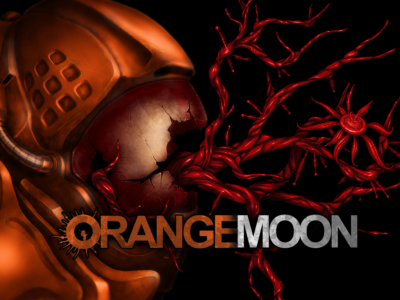
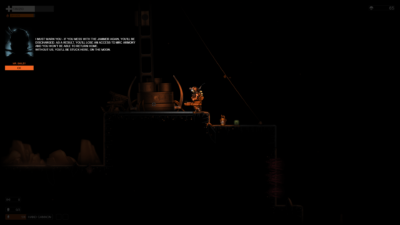 Oooh-eee! Sounds like a good time, huh? Some platforming, some complex puzzles… will I uncover all of Orange Moon’s secrets?
Oooh-eee! Sounds like a good time, huh? Some platforming, some complex puzzles… will I uncover all of Orange Moon’s secrets?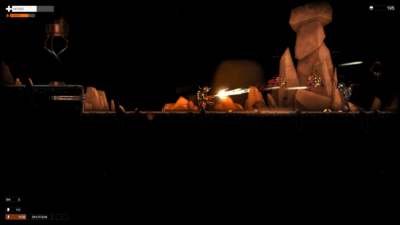 Fuel is tied to jumping, which means if you’re out or low you’ll spend a rather long amount of time waiting until you can climb out of a hole or make it through a jumping section, especially if you’re using the flamethrower a lot. This can be offset with upgrades, but the design isn’t really fun, it doesn’t add challenge, and it’s not interesting. Eventually, when upgraded, fuel is trivial and no longer serves a purpose, especially as the flamethrower becomes increasingly less useful. It just never seems to fit in with the rest of the game in a meaningful way that limits the player or forces choices outside of, “Do I want to wait a few minutes before I can climb out of this hole?”
Fuel is tied to jumping, which means if you’re out or low you’ll spend a rather long amount of time waiting until you can climb out of a hole or make it through a jumping section, especially if you’re using the flamethrower a lot. This can be offset with upgrades, but the design isn’t really fun, it doesn’t add challenge, and it’s not interesting. Eventually, when upgraded, fuel is trivial and no longer serves a purpose, especially as the flamethrower becomes increasingly less useful. It just never seems to fit in with the rest of the game in a meaningful way that limits the player or forces choices outside of, “Do I want to wait a few minutes before I can climb out of this hole?”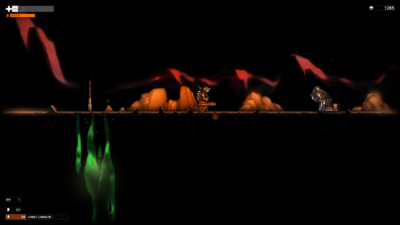 I think Orange Moon‘s most common problem is poor design. Enemies are not particularly difficult to deal with, often blocking a corridor perfectly with their height, acting almost as an aggressive door that needs to be unlocked with a shit load of ammo. Outside of the crappy turrets and plants all over the place, enemies tend to have a lot of hit points and armor that renders many guns useless without a lot of upgrades. All story is conveyed via text in the upper left corner of the screen, but when these kinds of events happen the entire screen darkens, aside from a small circle around your character, even if you’re in the middle of combat. Why do this? To force me to read this uninspiring story? Don’t interrupt the gameplay like that, man. That’s like the missus asking, “Are you done yet?” in the middle of “doin’ it”–it doesn’t really inspire enthusiasm, and it’s an extra unnecessary hurdle in trying to have some fuckin’ fun. Pile those two on top of my other complaints, and you don’t really have much of a reason to hang out in Orange Moon‘s world. Other games that are somewhat similar, even classics like Super Metroid accomplish the same thing without all the egregious errors.
I think Orange Moon‘s most common problem is poor design. Enemies are not particularly difficult to deal with, often blocking a corridor perfectly with their height, acting almost as an aggressive door that needs to be unlocked with a shit load of ammo. Outside of the crappy turrets and plants all over the place, enemies tend to have a lot of hit points and armor that renders many guns useless without a lot of upgrades. All story is conveyed via text in the upper left corner of the screen, but when these kinds of events happen the entire screen darkens, aside from a small circle around your character, even if you’re in the middle of combat. Why do this? To force me to read this uninspiring story? Don’t interrupt the gameplay like that, man. That’s like the missus asking, “Are you done yet?” in the middle of “doin’ it”–it doesn’t really inspire enthusiasm, and it’s an extra unnecessary hurdle in trying to have some fuckin’ fun. Pile those two on top of my other complaints, and you don’t really have much of a reason to hang out in Orange Moon‘s world. Other games that are somewhat similar, even classics like Super Metroid accomplish the same thing without all the egregious errors.



































































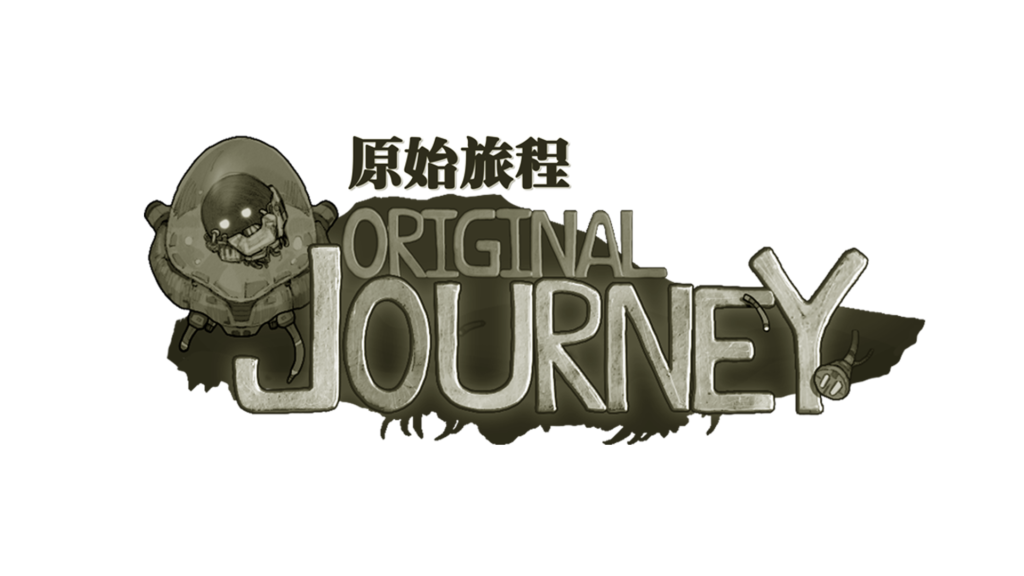
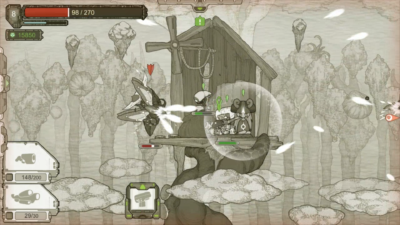 Alright, so in Original Journey (“original title do not steal”) you’re a plant thing in an exo suit on a mission with dozens of others to save your planet. For plot device reasons you’re not told why you’re on the planet Shadow (“original name do not steal”) aside from these green crystals, which, incidentally, a vibrant green object in an otherwise monochrome game. These things, you see, heal your folk and planet, or something. I don’t know. Anyway, a bunch more stuff happens that doesn’t even make sense in any context, like you needing to get monster teeth to make a translation program for your droid, or talking to a dude with amnesia that gives you an emerald-looking thing called a Chaos Key (“original concept and name do not steal”) and some schematics only your race could ever utilize. I don’t understand who’s writing this, or if it’s a translation error, but the story really needs, like… a spit shine, at least. It’s rough, and, at points: totally inane.
Alright, so in Original Journey (“original title do not steal”) you’re a plant thing in an exo suit on a mission with dozens of others to save your planet. For plot device reasons you’re not told why you’re on the planet Shadow (“original name do not steal”) aside from these green crystals, which, incidentally, a vibrant green object in an otherwise monochrome game. These things, you see, heal your folk and planet, or something. I don’t know. Anyway, a bunch more stuff happens that doesn’t even make sense in any context, like you needing to get monster teeth to make a translation program for your droid, or talking to a dude with amnesia that gives you an emerald-looking thing called a Chaos Key (“original concept and name do not steal”) and some schematics only your race could ever utilize. I don’t understand who’s writing this, or if it’s a translation error, but the story really needs, like… a spit shine, at least. It’s rough, and, at points: totally inane.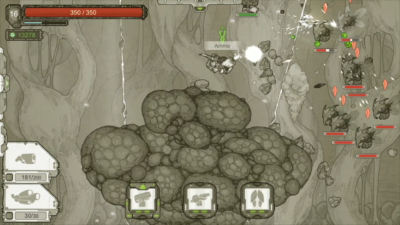 This title’s a sidescroller, and your character’s armament is limited to a suit (with a chip in it; think socketing items in Diablo or Path of Exile), a left weapon and a right weapon. Most of the weapons are guns, but for some reason you have no ability to aim these fucking things. Your vegetable’s aim sways back and forth at approximately an upward 45 degree angle, making anything with less spread than a shotgun annoying to use. Aiming directly at an enemy involves walking right next to them and fucking pulling the trigger. This means that often times, for air enemies, you’re jumping constantly in the air in order to do any good. Weapons have limited ammo, so often times you’ll be wasting most of your ammo trying to knock some bullshit out of the sky. This gets worse later, with enemies hanging out toward the bottom of the goddamn screen. WHY? WHY DO THIS? WHY THE FUCK CAN’T I AIM AT HIM? I HAVE TWO FUCKING GUNS AND I CA-
This title’s a sidescroller, and your character’s armament is limited to a suit (with a chip in it; think socketing items in Diablo or Path of Exile), a left weapon and a right weapon. Most of the weapons are guns, but for some reason you have no ability to aim these fucking things. Your vegetable’s aim sways back and forth at approximately an upward 45 degree angle, making anything with less spread than a shotgun annoying to use. Aiming directly at an enemy involves walking right next to them and fucking pulling the trigger. This means that often times, for air enemies, you’re jumping constantly in the air in order to do any good. Weapons have limited ammo, so often times you’ll be wasting most of your ammo trying to knock some bullshit out of the sky. This gets worse later, with enemies hanging out toward the bottom of the goddamn screen. WHY? WHY DO THIS? WHY THE FUCK CAN’T I AIM AT HIM? I HAVE TWO FUCKING GUNS AND I CA-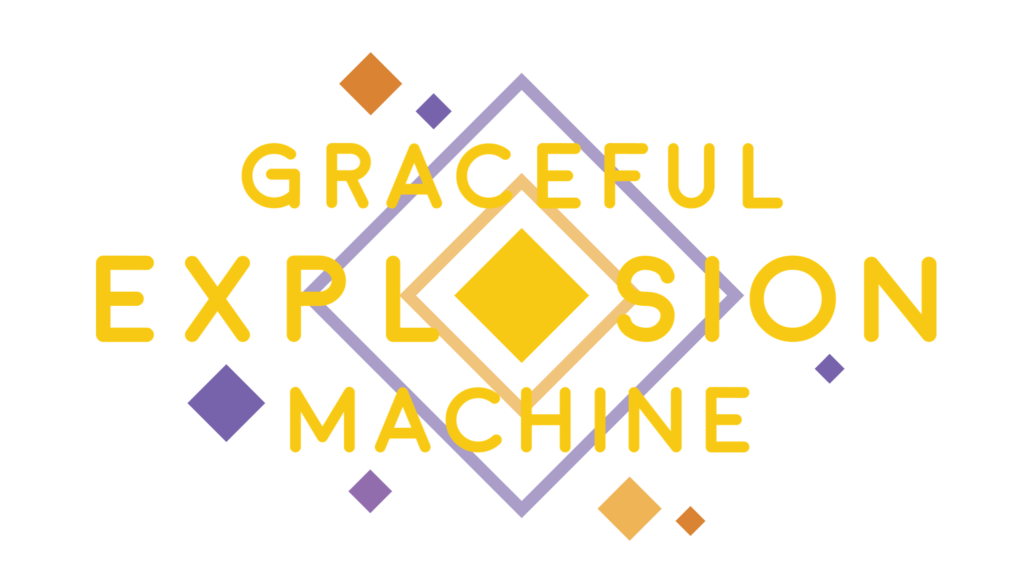
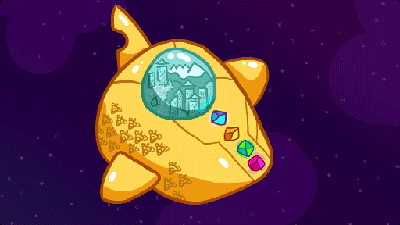
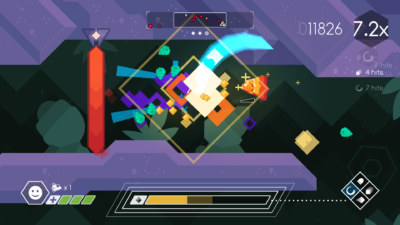 Now, for some reason this ship is unarmed until it picks up conspicuously laid out weapons in the tutorial, which is probably why these yellow guys got their shit ruined in the first place. First you get a pea shooter, which rapidly fires out blasts until it overheats, which is its only constraint. Second weapon, you get an “energy sword” which spins around twice on use, tearing into enemies and destroying enemy bullets. Next is a sniper beam, which is a very powerful beam that does a lot of damage and tears through enemy shields, but forces you to move slowly. The last is a missile barrage that can be directed out of your ship with a directional input before they race off to seek targets. With exception of the regular blaster, all weapons require weapon energy to fire. This is harvested from enemies on death via the yellow crystals they drop. The weapon energy meter doesn’t say what the max is, or how much each crystal is worth, nor is the energy required for attacks displayed anywhere, so it’s more of a fuel meter in that regard. Crystal/weapon power management seems to be the main bottleneck of player skill. Players need to swoop through slain enemies in order to get close enough to collect weapon power, which dictates how often you can use area of effect attacks. Gameplay quickly maxes out as an advanced game of chicken, blowing through enemies to collect weapon power to in turn massacre more enemies. The only real thing that mixes this up is how close enemies spawn, and if there’s an enemy that requires you to use the sniper cannon to kill quickly.
Now, for some reason this ship is unarmed until it picks up conspicuously laid out weapons in the tutorial, which is probably why these yellow guys got their shit ruined in the first place. First you get a pea shooter, which rapidly fires out blasts until it overheats, which is its only constraint. Second weapon, you get an “energy sword” which spins around twice on use, tearing into enemies and destroying enemy bullets. Next is a sniper beam, which is a very powerful beam that does a lot of damage and tears through enemy shields, but forces you to move slowly. The last is a missile barrage that can be directed out of your ship with a directional input before they race off to seek targets. With exception of the regular blaster, all weapons require weapon energy to fire. This is harvested from enemies on death via the yellow crystals they drop. The weapon energy meter doesn’t say what the max is, or how much each crystal is worth, nor is the energy required for attacks displayed anywhere, so it’s more of a fuel meter in that regard. Crystal/weapon power management seems to be the main bottleneck of player skill. Players need to swoop through slain enemies in order to get close enough to collect weapon power, which dictates how often you can use area of effect attacks. Gameplay quickly maxes out as an advanced game of chicken, blowing through enemies to collect weapon power to in turn massacre more enemies. The only real thing that mixes this up is how close enemies spawn, and if there’s an enemy that requires you to use the sniper cannon to kill quickly.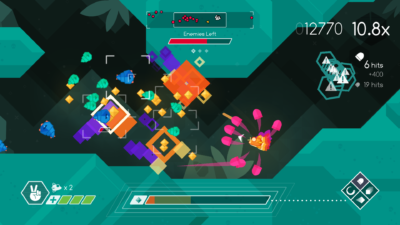 The game is divided into levels on four planets. A few open up for play, unlocking more as you complete them, culminating in a “warp” level to move on to the next planet. Each level has phases, which are this game’s checkpoint system; waves of enemies will spawn throughout an endlessly scrolling cave section as the player kills everything. Points are awarded for each kill, a multiplier in effect for consecutive kills and keeping a spree going. The ship is able to take three hits before dying, but each level has two continues, which can be utilized to restart from the beginning of the last phase that was started. The game isn’t exactly easy, but with tools like these, it’s not difficult either.
The game is divided into levels on four planets. A few open up for play, unlocking more as you complete them, culminating in a “warp” level to move on to the next planet. Each level has phases, which are this game’s checkpoint system; waves of enemies will spawn throughout an endlessly scrolling cave section as the player kills everything. Points are awarded for each kill, a multiplier in effect for consecutive kills and keeping a spree going. The ship is able to take three hits before dying, but each level has two continues, which can be utilized to restart from the beginning of the last phase that was started. The game isn’t exactly easy, but with tools like these, it’s not difficult either.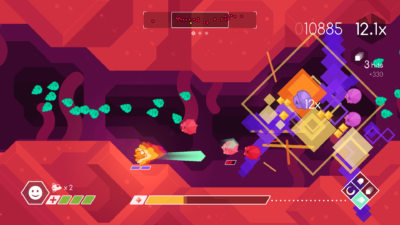 To its credit: the game runs well, and makes use of high refresh rate monitors. The music is benign, but not bad by any means. The controls on keyboard are serviceable, though I recommend controller. What’s more to say about a game that, mechanically, is solid even if there’s no carrot on the stick past score-whoring? There’s nothing particularly wrong with it, but it’s uninspiring, like a joke you’ve heard before, or a monologue on a topic you’re uninterested in.
To its credit: the game runs well, and makes use of high refresh rate monitors. The music is benign, but not bad by any means. The controls on keyboard are serviceable, though I recommend controller. What’s more to say about a game that, mechanically, is solid even if there’s no carrot on the stick past score-whoring? There’s nothing particularly wrong with it, but it’s uninspiring, like a joke you’ve heard before, or a monologue on a topic you’re uninterested in.


